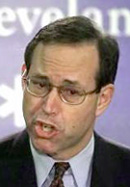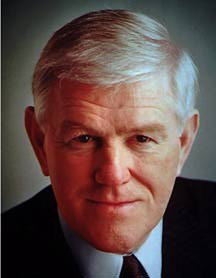Dayton Daily News Library
"The general assembly shall make such provisions, by taxation, or otherwise, as, with theincome arising from the school trust fund, will secure a thorough and efficient system of commonschools throughout the state."
School funding in Ohio
At Greenview South Elementary School in Jamestown, music is taught in a trailer because there is no room in the school.
DDN photo by Jim Witmer
| On March 24, 1997 the Ohio Supreme Court ruled Ohio's school funding system unconstitutional and ordered state officials to replace it within a year.
Judge Linton Lewis Jr., of Perry County Common Pleas Court, made the original ruling in the case and was empowered by the Court to rule on any new plan.
In July, 1997, then-Gov. George Voinovich and fellow Republicans proposed a 1-cent sales tax, but the plan died in the Ohio House. |
 Voinovich Voinovich |
In February 1998 the Ohio Legislature approved a new school funding plan, but left to voters to decide on a proposed increase in the state sales tax But on May 5, 1998 Ohio voters overwhelmingly rejected Issue 2. Though backed by Voinovich, the proposal was opposed both by anti-tax conservatives as well as by most local school administrators, who said Issue 2 did not go far enough.
 Taft Taft |
In August of that year Lewis conducted hearings on whether the state had met its obligation and on Feb. 26, 1999 he ruled that the funding system remained unconstitutional. Lewis gave the state until the end of 1999 to come up with a new plan.
"While that funding system has a few new names and new programs, it functions at virtually the same inadequate level it did in 1993," Lewis said in a strongly worded decision. The changes "are largely changes of form and not substance."
In a joint statement, Gov. Bob Taft, House Speaker Jo Ann Davidson, R-Reynoldsburg, and Senate President Richard Finan, R-Cincinnati, said they were disappointed with Lewis' ruling and would call for an appeal to the Ohio Supreme Court. |
Origin of the case: The Ohio Constitution requires the state to provide a thorough andefficient system of education.
A little more than half the money for public education comes fromlocal taxes and a little less than half comes from the state. A small portionof federal assistance makes up the difference.
But, because of differences in property values and wealth in each district,per-pupil spending ranged from as high as $12,000 a year per student to as lowas $4,000.
That disparity was the basis for the legal challenge, which began in 1991 when the Ohio Coalition for Equity & Adequacy of School Funding files suit in Perry County Common Pleas Court on behalf of Northern Local Schools student Nathan DeRolph.
 "By our decision today, we send a clear message to lawmakers: the time has come to fix the system . . . Let there be no misunderstanding. Ohio's public school financing scheme must undergo a complete systematic overhaul. . ." "By our decision today, we send a clear message to lawmakers: the time has come to fix the system . . . Let there be no misunderstanding. Ohio's public school financing scheme must undergo a complete systematic overhaul. . ."
"Our state Constitution makes the state responsible for educating our youth. Thus, the state should not shirk its obligation by espousing cliches about 'local control.'"-- Justice Francis E. Sweeney, writing for the majority
 Judge Linton Lewis of Perry County made the original ruling in 1994, and the state must submit any reorganization plans to him for approval. Linton's 1994 ruling outlined criteria the state must meet. 1999 ruling: In his 2-26-1999 ruling, Lewis said:"While that funding system has a few new names and new programs, it functions at virtually the same inadequate level it did in 1993. (The changes) are largely changes of form and not substance.""The court finds that the problem of undue reliance upon local property taxes used by school districts remains as much of a problem now as it was in 1993, and it may even be worse." | Chronology: DECEMBER 1991: The Ohio Coalition for Equity & Adequacy of School Fundingfiles suit in Perry County Common Pleas Court on behalf of Northern LocalSchools student Nathan DeRolph and others. The lawsuit challenges the state's school fundingsystem as unconstitutional.
OCT. 13, 1993: Judge Daniel Corrigan of Cuyahoga County Common PleasCourt bars the Perry County case from proceeding because of a similar casepending in Cleveland.
OCT. 19, 1993: The Ohio Supreme Court blocks enforcement of Corrigan'sorder.
OCT. 25, 1993: Trial of the coalition's lawsuit begins in Perry County.
DEC. 8, 1993: Trial ends.
JULY 1, 1994: Judge Linton Lewis Jr. rules the state system of financingeducation is unconstitutional.
AUG. 30, 1995: Ohio's 5th District Court of Appeals in Canton overturnsLewis' ruling.
JANUARY 1996: Ohio Supreme Court agrees to hear case.
SEPT. 10, 1996: Supreme Court hears oral arguments.
MARCH 24, 1997: Ohio Supreme Court declares school funding systemunconstitutional.
July 2, 1997: Gov. George Voinovich and Republican legislative leaders propose a 1-cent sales tax hike to raise money to meet court order. The plans dies in the Ohio House.
AUG. 3, 1997 -- The Legislature fails to agree on a school funding proposal.
FEB. 17, 1998 -- The Legislature votes to put a sales tax increase before voters. Issue 2 would raise the state sales tax by one cent for new funding for schools, but would also cut property taxes.
MAY 5, 1998 -- Issue 2 is resoundingly defeated by voters.
Aug. 24 to Sept 3, 1998: Lewis holds hearings on whether state complied with Supreme Court order. State says it has boosted school funding, even without the tax.
Feb. 26, 1999: Lewis rules that the funding system remains unconstitutional.
|
Selected Dayton Daily News stories:COURT VOIDS SYSTEM
OHIO SCHOOL FUNDING UNCONSTITUTIONAL
Published: Saturday, July 2, 1994 Page: 1A
By: By Tim Miller COLUMBUS BUREAUCOURT VOIDS SYSTEM FOR FUNDING SCHOOLS
NEW PLAN ORDERED IN A YEAR
Published: Tuesday, March 25, 1997 Page: 1A
By: By Tim Miller COLUMBUS BUREAU JUDGE'S GOAL FOR SCHOOLS
Published: Wednesday, March 26, 1997 Page: 8A SCHOOLS
JUDGE LEWIS TO DECIDE WHAT'S BEST
* The General Assembly will have few options but to follow hisdirection, expert says.
Published: Wednesday, March 26, 1997 Page: 8A
By: By Debra Jasper Columbus Bureau SCHOOL FUNDING
GOVERNOR'S PLAN STALLS IN HOUSE
Published: Thursday, July 31, 1997 Page: 1A
By: By Tim Miller COLUMBUS BUREAU SCHOOL FUNDING PLAN IN PLACE
Lawmakers at odds over ways to pay for it
Published: Monday, February 2, 1998 Page: 1A
By: By Tim Miller Columbus Bureau SCHOOL FUNDING
TAX HEADED FOR BALLOT
* Approved by the Senate, a proposed sales tax increase awaits thegovernor's signature and then approval by voters.
Published: Wednesday, February 18, 1998 Page: 1A
By: By Tim Miller Columbus Bureau STATEWIDE ELECTION
SCHOOL SALES TAX KILLED
* Issue 1, which would have allowed the state to issue school construction bonds, alsofails.
Published: Wednesday, May 6, 1998 Page: 1A
By Tim Miller Columbus Bureau Click below to generate a search on the Dayton Daily News library for more stories on this topic. |
File Created: 4-20-1997
Updated: 5-6-1998
Prepared by: Dayton Daily News Library staff
Sources: DDN reports
|



 "By our decision today, we send a clear message to lawmakers: the time has come to fix the system . . . Let there be no misunderstanding. Ohio's public school financing scheme must undergo a complete systematic overhaul. . ."
"By our decision today, we send a clear message to lawmakers: the time has come to fix the system . . . Let there be no misunderstanding. Ohio's public school financing scheme must undergo a complete systematic overhaul. . ."